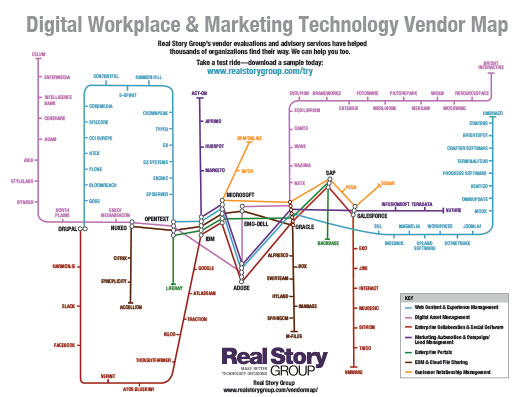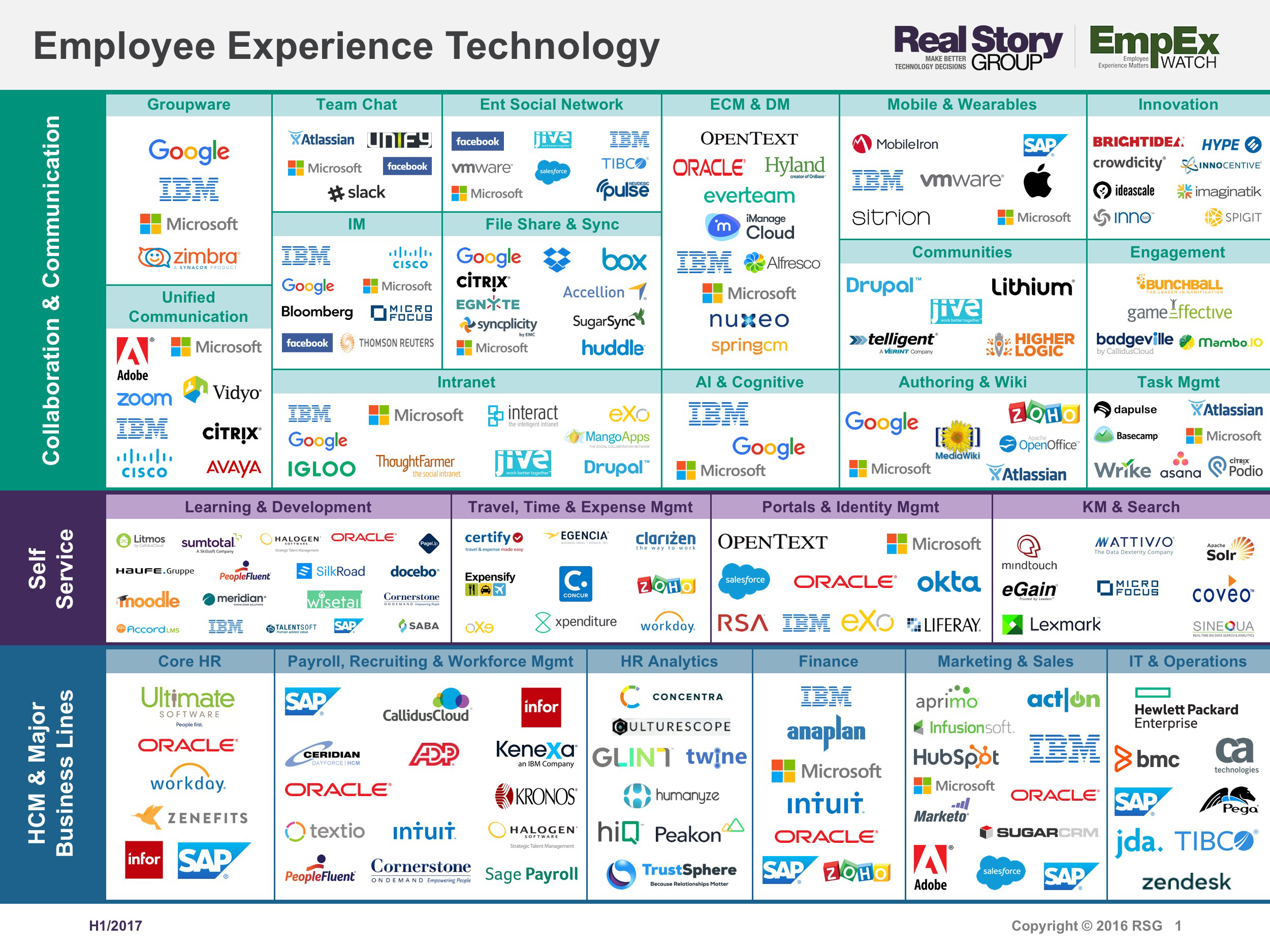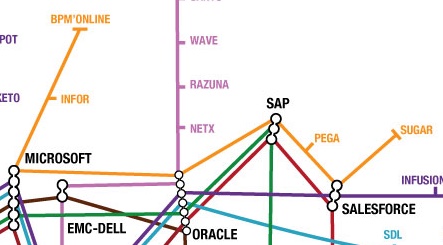2018 Predictions for Digital Leaders
What does RSG see coming in 2018? As usual we eschew heady concepts in favor of more practical predictions, along with our annual caveat that we're typically only 70-80% correct. Want to learn more? Sign up for immediate access to RSG's on-demand fast-paced webinar on these predictions.
In the meantime, here's a preview of the twelve trends.
Digital Workplace Predictions
1. Office 365 Supplants SharePoint
It's official: Redmond is putting almost all its digital workplace energy into Office 365. Where SharePoint was once a way to "connect Office to the Web," it's now a somewhat lagging piece of an O365 environment that favors single-purpose applications over omnibus platforms. Look for SharePoint Online to get carved up a bit next year, though that's not necessarily a bad thing. What about SharePoint 2019 on-premise? For Redmond it's an obligation, like tending to an ailing uncle.

Get a high-resolution version of this map.
2. Community Manager Revolt
If your local digital workplace community manager has seen specialized community tooling get replaced by behemoth ESNs from the likes of Microsoft (Yammer), Chatter (Salesforce), or Facebook (Workplace) — then chances are she's pissed. Communities are the tip of the social spear; do them well and good things will follow. A real community technology platform is not essential for enterprise social success, but in its absence community managers — and employees — have to work that much harder. We're seeing some quiet revolts now and expect more to come next year.
3. Cambrian Explosion of Digital Workplace Tools
Scott Brinker has charted a "Cambrian Explosion" of digital marketing tools over the past five years. We think 2018 will herald a similar expansion of toolsets within enterprises struggling to transform atop heavyweight platforms from infrastructure vendors. Slack was an early warning. There's more coming.

The EmpEx 200 (click to enlarge). Source: RSG
4. EmpEx Centers of Excellence
With the profusion of workplace tools in the average employee's digital day, enterprises will begin to address experience needs outside the context of a single platform or system. Emerging standards and style guides inherited from Intranet teams will help, but leading enterprises will create employee experience (EmpEx) centers of excellence...in fact that's a great new remit for your Intranet team.
5. Small-P Workplace Portals
That same profusion of tools is re-invigorating calls for personalized employee (shiver!) "portals." To be sure, there's still a role for capital-P portal tools from the likes of IBM, Liferay, and Oracle. But the new portals are going to be lightweight, low-code ("aPaaS") environments, and likely more fit-for-purpose than one-size-fits-all enterprise gateways.
6. DAM for Your Digital Workplace
Historically, Digital Asset Management technology has served outward-facing use cases: for publishing, broadcasting, marketing, customer engagement, and the like. 2018 will see an emerging use case around using DAM tools for internal knowledge management use cases, especially as enterprise knowledge becomes more componentized and media-based.
Digital Marketing & Customer Engagement Predictions
1. CDP Explosion
Customer Data Platforms are hot. To be sure, not everyone knows what to do with them (if your employer is an RSG subscriber, this advisory briefing might help), but for larger B2C enterprises in particular, CDPs are emerging as part of the default stack conversation, and we expect to see substantial uptake of these tools in 2018.
2. Vertical CRM Implosion
Many enterprises still rely on CRM services from industry-oriented management systems. We see this a lot in Manufacturing, Non-Profits, and Higher Education, but it remains quite widespread elsewhere, especially among mid-sized organizations. This approach has been changing rapidly over the past few years as enterprises get more sophisticated about CRM practices and seek the interoperability and extensibility of one of the "Big 8" platforms. We see a virtual implosion of vertically-specific CRM vendors next year.

RSG now evaluates eight major CRM vendors.
3. DAM Vendor Market Split
RSG now categorizes DAM vendors on a traditional complexity spectrum ranging from platforms to simpler products. Yet we sense a couple important dividing lines will become particularly glaring in 2018. First, comprehensive video support will emerge as a critical differentiator. Also, the ability to manage and track compound assets in a fully object-oriented way is going to separate DAM vendors who can effectively support advanced marketing and engagement use cases from those who cannot.
4. Rethinking Segments and Campaigns in Your Marketing Automation Platform
Traditionally focused on email and other outbound communications, major marketing automation platforms have attempted in recent years to reinvent themselves as broader segmentation, personalization, and campaign management and orchestration environments. But this has exposed several key limitations, not the least that they are bound to specific delivery channels and data sets. We see savvier customers moving these services lower in their engagement stacks in 2018.
5. Marketing Dashboard Revival
Earlier this decade dashboards were all the rage; then enterprises discovered the challenges of usable reports, quality data, and comprehensive integration in multi-channel, multi-system environments. Today, REST APIs are making it easier to connect disparate data sets, and CDPs are expanding to include analytics services. We'll see a new run on dashboards for marketers in 2018.
6. Headless WCM Backlash
Headless Web Content & Experience Management architectures are all the rage these past few years, and with some reason: they support injecting content into interactive and transactional applications where many of your customers present themselves digitally. The problem with headless services is that marketers often lose out on shaping actual experiences — something they fought hard for over the past decade. Absent any experience-as-a-service capabilities, we'll see customer engagement leaders resisting a complete cut-over to headless in many cases.
Want to learn more or ask deep-dive questions? Register here for immediate access to the on-demand webinar.





![[Webinar] The Right Way to Select Technology for Your New Omnichannel Stack](/sites/default/files/styles/blog_thumbnail/public/blog/Omnichannel%20Stack%20Selection%202020%20small.jpeg?itok=-u84mYo8)


